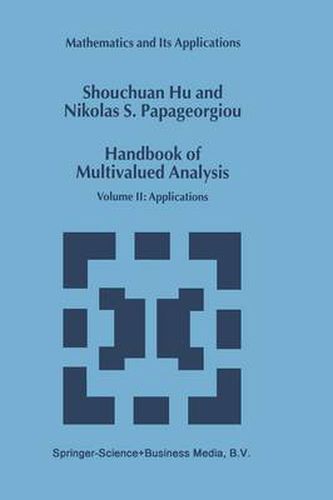Readings Newsletter
Become a Readings Member to make your shopping experience even easier.
Sign in or sign up for free!
You’re not far away from qualifying for FREE standard shipping within Australia
You’ve qualified for FREE standard shipping within Australia
The cart is loading…






This title is printed to order. This book may have been self-published. If so, we cannot guarantee the quality of the content. In the main most books will have gone through the editing process however some may not. We therefore suggest that you be aware of this before ordering this book. If in doubt check either the author or publisher’s details as we are unable to accept any returns unless they are faulty. Please contact us if you have any questions.
In volume I we developed the tools of Multivalued Analysis.
In this volume we examine the applications. After all, the initial impetus for the development of the theory of set-valued functions came from its applications in areas such as control theory and mathematical economics. In fact, the needs of control theory, in particular the study of systems with a priori feedback, led to the systematic investigation of differential equations with a multi valued vector field (differential inclusions). For this reason, we start this volume with three chapters devoted to set-valued differential equations. However, in contrast to the existing books on the subject (i. e. J. -P. Aubin - A. Cellina: Differential Inclusions, Springer-Verlag, 1983, and Deimling: Multivalued Differential Equations, W. De Gruyter, 1992), here we focus on Evolution Inclusions, which are evolution equations with multi valued terms. Evolution equations were raised to prominence with the development of the linear semigroup theory by Hille and Yosida initially, with subsequent im portant contributions by Kato, Phillips and Lions. This theory allowed a successful unified treatment of some apparently different classes of nonstationary linear par tial differential equations and linear functional equations. The needs of dealing with applied problems and the natural tendency to extend the linear theory to the nonlinear case led to the development of the nonlinear semigroup theory, which became a very effective tool in the analysis of broad classes of nonlinear evolution equations.
$9.00 standard shipping within Australia
FREE standard shipping within Australia for orders over $100.00
Express & International shipping calculated at checkout
This title is printed to order. This book may have been self-published. If so, we cannot guarantee the quality of the content. In the main most books will have gone through the editing process however some may not. We therefore suggest that you be aware of this before ordering this book. If in doubt check either the author or publisher’s details as we are unable to accept any returns unless they are faulty. Please contact us if you have any questions.
In volume I we developed the tools of Multivalued Analysis.
In this volume we examine the applications. After all, the initial impetus for the development of the theory of set-valued functions came from its applications in areas such as control theory and mathematical economics. In fact, the needs of control theory, in particular the study of systems with a priori feedback, led to the systematic investigation of differential equations with a multi valued vector field (differential inclusions). For this reason, we start this volume with three chapters devoted to set-valued differential equations. However, in contrast to the existing books on the subject (i. e. J. -P. Aubin - A. Cellina: Differential Inclusions, Springer-Verlag, 1983, and Deimling: Multivalued Differential Equations, W. De Gruyter, 1992), here we focus on Evolution Inclusions, which are evolution equations with multi valued terms. Evolution equations were raised to prominence with the development of the linear semigroup theory by Hille and Yosida initially, with subsequent im portant contributions by Kato, Phillips and Lions. This theory allowed a successful unified treatment of some apparently different classes of nonstationary linear par tial differential equations and linear functional equations. The needs of dealing with applied problems and the natural tendency to extend the linear theory to the nonlinear case led to the development of the nonlinear semigroup theory, which became a very effective tool in the analysis of broad classes of nonlinear evolution equations.